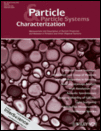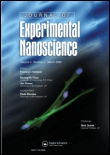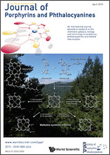
Journal of Nanostructure in Chemistry
metrics 2024
Leading the Charge in Nanostructure Research
Introduction
The Journal of Nanostructure in Chemistry, published by Springer Heidelberg, stands at the forefront of nanotechnology and its applications in the field of chemistry. With an impressive Q1 ranking in Chemistry (Miscellaneous) as of 2023, this journal offers a platform for disseminating groundbreaking research and innovative practices that shape the future of nanostructured materials. Recognized among the top-tier publications in its category—with a commendable 96th percentile ranking in Scopus—this journal provides researchers, professionals, and students alike with invaluable insights into the intricate interplay between nanoscale structures and chemical principles. Despite being a non-open access platform, its commitment to high-quality, peer-reviewed content continues to drive scientific discourse and collaboration within the international research community. The Journal of Nanostructure in Chemistry, which spans from 2013 to 2024, is dedicated to advancing knowledge and fostering innovation in nanochemistry, making it an essential resource for anyone looking to stay ahead in this rapidly evolving discipline.
Metrics 2024
 1.26
1.26 8.60
8.60 8.60
8.60 59
59Metrics History
Rank 2024
Scopus
IF (Web Of Science)
JCI (Web Of Science)
Quartile History
Similar Journals

Nano Materials Science
Connecting Researchers with Cutting-edge Discoveries.Nano Materials Science is a premier open-access journal dedicated to the dissemination of groundbreaking research in the fields of nanotechnology, materials science, and chemical engineering. Published by KEAI PUBLISHING LTD, this journal has quickly established itself as a leading platform in its area since its inception in 2019, with impressive rankings in the Scopus database, holding a Q1 position across multiple categories, including Chemical Engineering and Materials Science. Based in Beijing, China, Nano Materials Science provides researchers and practitioners access to a wealth of high-quality peer-reviewed articles, fostering innovation and collaboration within the scientific community. With its impact factor steadily rising and a commitment to open access, the journal aims to bridge the gap between theoretical research and practical applications, making it an essential resource for professionals and students eager to stay at the forefront of materials research and nanotechnology advancements.

FULLERENES NANOTUBES AND CARBON NANOSTRUCTURES
Connecting Researchers to the Cutting Edge of Carbon ScienceFULLERENES NANOTUBES AND CARBON NANOSTRUCTURES, published by Taylor & Francis Inc, stands at the forefront of research in the fields of nanotechnology, materials science, and organic chemistry. With an ISSN of 1536-383X and an E-ISSN of 1536-4046, this journal offers a critical platform for disseminating significant findings related to carbon-based nanostructures, materials characterization, and their innovative applications. Recognized for its scholarly impact, the journal enjoys a Q2 ranking in several fields, including Atomic and Molecular Physics, Materials Science, and Organic Chemistry, reflecting its commitment to quality research. Since its inception in 2002, it has maintained a rigorous publication standard and provides open access options, enabling a diverse audience, from researchers to industry professionals, to engage with the latest advancements. The journal's comprehensive scope across converged years until 2024 emphasizes its pivotal role in fostering knowledge in the rapidly evolving realm of nanoscience and nanotechnology. Researchers and practitioners alike are encouraged to explore the cutting-edge research showcased in this vital resource.

Journal of Nano Research
Leading the Charge in Nano DiscoveriesThe Journal of Nano Research, published by Trans Tech Publications Ltd, is a distinguished academic journal dedicated to the rapidly evolving field of nanotechnology and materials science. With an ISSN of 1662-5250 and an E-ISSN of 1661-9897, the journal has been an important platform for researchers and professionals since its inception in 2008, continuing to provide high-quality peer-reviewed research through to 2024. Nestled in Switzerland, the Journal of Nano Research plays a pivotal role in disseminating cutting-edge findings, as recognized by its categorization in Q3 for Materials Science and Physics while being positioned in Q4 for Nanoscience and Nanotechnology as of 2023. With Scopus rankings highlighting its impact, including Rank #129 in general Physics and Astronomy and Rank #300 in Materials Science, this journal is crucial for academics seeking to stay ahead in research trends and innovations in nano-related disciplines. Although it operates under a subscription model, the journal's objectives include fostering collaboration and knowledge-sharing among researchers, making it an invaluable resource for anyone immersed in the world of nanotechnology.

Materials Letters-X
Fostering Innovation in Condensed Matter PhysicsMaterials Letters-X, published by ELSEVIER, is an esteemed open-access journal dedicated to the rapid communication of research in the fields of Condensed Matter Physics, Materials Science, Mechanical Engineering, and Mechanics of Materials. Launched in 2019, this journal has quickly established itself within the academic community, achieving Q3 quartile rankings in several categories according to the 2023 metrics. The journal's impactful contributions are reflected in its Scopus rankings, notably within Mechanical Engineering (Rank #308) and Mechanics of Materials (Rank #199). The open-access model promotes widespread dissemination and accessibility, ensuring that cutting-edge advancements in material science are readily available to researchers, professionals, and students worldwide. As it continues to grow, Materials Letters-X aims to inspire innovation and collaboration across disciplines, making it a pivotal resource for those engaged in material research and applications.

Micro & Nano Letters
Pioneering research at the forefront of technology.Micro & Nano Letters is a prominent open-access journal published by WILEY, dedicated to advancing the fields of micro and nanoscale science and technology. Since its inception in 2007, the journal has been a valuable resource for researchers, professionals, and students, delivering high-quality research that supports innovation and collaboration in bioengineering, biomedical engineering, condensed matter physics, materials science, and nanoscience. With an impact factor that reflects its growing influence, Micro & Nano Letters has earned recognition in various Scopus categories, including a Q3 ranking in both Condensed Matter Physics and Materials Science as of 2023. Its commitment to open access, established in 2021, ensures that the latest developments in micro- and nanotechnologies are accessible to a global audience, fostering a multidisciplinary dialogue across academia and industry. The journal continues to play a critical role in disseminating cutting-edge research and promoting technological advancements worldwide.

PARTICLE & PARTICLE SYSTEMS CHARACTERIZATION
Unraveling the Mysteries of Particulate SystemsPARTICLE & PARTICLE SYSTEMS CHARACTERIZATION is a distinguished journal dedicated to advancing the knowledge within the fields of Chemistry, Condensed Matter Physics, and Materials Science. Published by WILEY-V C H VERLAG GMBH in Germany, this journal has established a solid reputation since its inception in 1984, showcasing research aimed at understanding the intricate properties and behaviors of particulate systems. With an impressive Q2 ranking in its respective categories and Scopus ranks indicating a robust standing in the global research community, it serves as an essential resource for researchers, professionals, and students. Although it does not currently offer Open Access options, its comprehensive articles and reviews provide valuable insights that contribute significantly to the ongoing discourse in these scientific domains. As it prepares to celebrate four decades of publication, PARTICLE & PARTICLE SYSTEMS CHARACTERIZATION continues to provide a vital platform for emerging knowledge, fostering innovation and collaboration among scientists dedicated to the study of particle systems.

Journal of Experimental Nanoscience
Transforming Ideas into Nanoscientific InnovationsThe Journal of Experimental Nanoscience, published by Taylor & Francis Ltd, is an esteemed open-access journal dedicated to advancing the field of nanoscience and its applications across various disciplines. Since its establishment, the journal has aimed to provide a comprehensive platform for researchers and professionals to disseminate innovative findings in nanotechnology, bioengineering, and materials science. With an ISSN of 1745-8080 and E-ISSN of 1745-8099, this journal has been pivotal in promoting high-quality research in its converged years from 2006 to 2024. Recognized for its contributions, it currently holds a Q3 ranking in core categories such as Bioengineering, Biomedical Engineering, Materials Science, and Nanoscience and Nanotechnology. Although its H-index is not specified, its Scopus ranks reflect its growing influence, with notable percentiles in various engineering fields. By offering open access since 2016, the Journal of Experimental Nanoscience enhances the accessibility of vital research to a global audience. Researchers, professionals, and students will find this journal an invaluable resource for staying abreast of the latest advancements and breakthroughs in nanoscience.

Materials Futures
Driving discoveries that redefine materials innovation.Materials Futures, an esteemed journal published by IOP Publishing Ltd, stands out as a pivotal resource in the field of Materials Science, with a particular emphasis on Biomaterials. Launched in 2022 and operating under an Open Access model, the journal aims to foster accessibility and rapid dissemination of pioneering research, thus catering to the diverse needs of researchers, professionals, and students globally. With a commendable Scopus Rank of #46 out of 137 in its category, placing it in the 66th percentile, and recognized as a Q1 journal as of 2023, Materials Futures provides a vital platform for cutting-edge studies and innovations that address contemporary challenges in materials science. As the journal evolves through its convergence period from 2022 to 2024, it continues to attract high-quality submissions aimed at advancing knowledge and applications within the biomaterials sector, reflecting its commitment to contributing vital insights and fostering collaboration across disciplines. Explore Materials Futures for your research endeavors and join a community dedicated to shaping the future of materials.

Discover Nano
Fostering Innovation through Collaborative ResearchDiscover Nano is a pioneering journal published by SPRINGER, dedicated to the rapidly evolving field of nanoscience and nanotechnology. Established in 2023, this innovative platform provides an open-access forum for researchers, professionals, and students to share and disseminate cutting-edge findings in materials science and condensed matter physics. With its commitment to accessibility, Discover Nano encourages a broad spectrum of contributions, aiming to foster collaboration and stimulate discussion in this dynamic area of study. As a new entry into the academic community, the journal holds great potential for growth, aspiring to increase its visibility and impact in the materials science arena, where it currently ranks in the bottom quartile for both materials science and physics categories. Based in Germany and reaching a global audience, Discover Nano represents a significant opportunity for those looking to shape the future of nanotechnology through impactful research and interdisciplinary dialogue.

JOURNAL OF PORPHYRINS AND PHTHALOCYANINES
Innovative Research in Chemistry and Materials ScienceJOURNAL OF PORPHYRINS AND PHTHALOCYANINES, published by WORLD SCIENTIFIC PUBL CO PTE LTD, is an influential peer-reviewed journal dedicated to advancing the field of porphyrins and phthalocyanines, key compounds in both chemistry and materials science. With an ISSN of 1088-4246 and an E-ISSN of 1099-1409, this journal has been a vital resource since its inception in 1997 and is expected to continue until 2024. The journal holds a respectable position in the academic landscape, categorized in the Q3 quartile for miscellaneous Chemistry journals and ranked #252 out of 408 in the general chemistry category according to Scopus, reflecting a growing impact in the field despite its current percentile standing at 38th. JOURNAL OF PORPHYRINS AND PHTHALOCYANINES seeks to publish original research articles, reviews, and critical studies that explore the synthesis, characterization, and applications of these versatile compounds, which play essential roles in numerous scientific disciplines, from catalysis to materials development. This journal is an indispensable platform for researchers and professionals seeking to disseminate their findings, engage with contemporary discussions, and stay informed about cutting-edge advancements in porphyrin and phthalocyanine research.